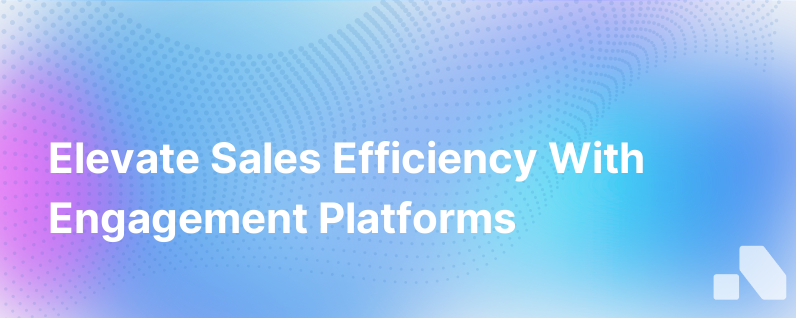
In the rapidly evolving landscape of B2B sales, time is the currency of success. Efficiency has become not only a goal but a necessity for sales teams aiming to stay competitive and optimize their processes. Sales engagement platforms (SEPs) have emerged as a transformative tool, fundamentally reshaping the way sales teams operate by automating routine tasks, streamlining communication, and providing actionable insights. In this article, we will deep dive into how SEPs can boost your team’s sales efficiency.
Understanding Sales Engagement Platforms
A Sales Engagement Platform is a comprehensive suite that facilitates interactions between sales professionals and potential customers. It encompasses various tools designed to streamline the multiple touchpoints involved in the sales process, including emails, social media interactions, phone calls, and video meetings.
SEPs integrate with customer relationship management (CRM) systems, various communication channels, and productivity tools to create a seamless ecosystem for sales activities. Key features often include email automation, call dialers, scheduling assistants, content management, performance analytics, and guided selling.
Enhancing Sales Efficiency with SEPs
Deploying a Sales Engagement Platform can significantly enhance the performance of sales teams by improving the following areas:
1. Streamlining Administrative Tasks
One of the core benefits of SEP is its ability to take administrative tasks off the plates of salespeople, who often find themselves spending inordinate amounts of time on data entry, scheduling follow-ups, and managing emails. Automation features within SEPs can handle such tasks, allowing sales reps to dedicate more time to engaging with prospects.
2. Providing Actionable Insights
A top-notch SEP not only collects data but turns it into understandable insights which help sales reps understand which activities lead to sales and which don’t. Real-time analytics on email open rates, click-through rates, and response times inform strategic decisions and help tailor future interactions.
3. Harnessing Personalized Communications
With features like customizable templates and sequences, SEPs enable personalization at scale. Email templates can be tailored with dynamic fields that pull in prospect-specific information, making each communication feel personal and relevant.
4. Optimizing Follow-up
SEPs often include smart follow-up features such as automated reminders and next-step suggestions, ensuring sales reps follow up with leads at the optimal moments. This consistency significantly increases the chances of conversion.
5. Standardizing Sales Messaging
A repository of approved, on-message content available within these platforms ensures that sales reps have immediate access to the most effective and compliant collateral, presentations, and proposal templates, ensuring a consistent brand voice across the customer journey.
6. Advancing the Sales Cadence
SEPs typically include tools for designing and managing sales cadences — structured sequences of sales activities designed to engage prospects. This structured approach, guided by best practices and data-driven optimizations, allows for a more predictable and successful sales process.
7. Scaling Best Practices
Replicating the success of top performers becomes manageable with SEPs, as their strategies and most effective practices can be codified into templates and playbooks for the rest of the team to utilize.
8. Integrating with Other Tools
Through integration with CRMs and other business software, information flows seamlessly between systems, reducing the risk of errors and the need for data duplication.
9. Mobilizing Sales Teams
With mobile access to SEPs, sales professionals are no longer desk-bound. The ability to prepare for meetings, access sales content, and update customer records on the go is indispensable in today's mobile-centric work environment.
Adopting SEPs for Startups and SMBs
While large enterprises have been swift to adopt Sales Engagement Platforms, it’s just as imperative for startups and small to medium-sized businesses (SMBs) to leverage these tools. Here’s how SEPs can transform sales in smaller-scale operations:
- Lower Barrier to Entry: Many SEPs offer flexible pricing models to cater to smaller teams, making enterprise-grade sales tools accessible without a hefty initial investment.
- Rapid Onboarding: With intuitive designs and comprehensive support, SEPs tend to have a relatively quick learning curve, which is crucial for teams that need to hit the ground running.
- Agility: Startups and SMBs can quickly tweak and iterate their sales strategies based on real-time data from SEPs, which is often a competitive differentiator.
Selecting the Right SEP
When evaluating SEPs for your sales team, it’s essential to consider:
- Integration Capabilities: Ensure the platform syncs with your existing tech stack, particularly your CRM.
- Scalability: Opt for a SEP that can grow with your organization, accommodating an increasing user base and evolving sales strategies.
- Support and Training: Look for providers that offer comprehensive support and training resources to ensure adoption and proficiency across your team.
- Compliance and Security: Robust privacy features and regulatory compliance are non-negotiable, especially with growing concerns over data security.
In conclusion, a Sales Engagement Platform can be a cornerstone in building an efficient, data-driven sales process. By automating routine tasks, equipping sales teams with actionable insights, and facilitating personalization at scale, SEPs enable sales professionals to maximize their time, build meaningful relationships with prospects, and ultimately close more deals.
While tools like Aomni make aspects of the SEP process even smoother, the idea is to empower reps with a comprehensive toolset that allows them to focus on what they do best — sell. Adopting a SEP might just be the strategic decision that transforms your sales outcomes and propels your business forward.